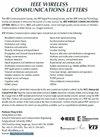超密集低轨道网络的快速波束布局
IF 5.5
3区 计算机科学
Q1 COMPUTER SCIENCE, INFORMATION SYSTEMS
引用次数: 0
摘要
与地球静止轨道(GSO)卫星相比,低地球轨道(LEO)卫星带来了无线通信的重大改进,其特点是低延迟和减少传输损耗。超密集低轨道卫星可以通过产生有效的有源波束来服务于许多用户。波束放置问题具有挑战性,但对于在大量用户中有效分配资源非常重要。本文提出并解决了一个用于超密集卫星系统的快速波束布置优化问题,以最小的有源波束数(nab)增强链路预算。为了实现这一目标并在多项式时间内平衡波束之间的负载,我们提出了两种针对大型用户群的算法,利用改进的K-means聚类和图论。数值结果表明,在统计信道增益噪声比和最先进的基准计算时间方面,这些建议是有效的。本文章由计算机程序翻译,如有差异,请以英文原文为准。
Fast Beam Placement for Ultra-Dense LEO Networks
Low Earth orbit (LEO) satellites has brought about significant improvements in wireless communications, characterized by low latency and reduced transmission loss compared to geostationary orbit (GSO) satellites. Ultra-dense LEO satellites can serve many users by generating active beams effective to their locations. The beam placement problem is challenging but important for efficiently allocating resources with a large number of users. This letter formulates and solves a fast beam placement optimization problem for ultra-dense satellite systems to enhance the link budget with a minimum number of active beams (NABs). To achieve this goal and balance load among beams within polynomial time, we propose two algorithms for large user groups exploiting the modified K-means clustering and the graph theory. Numerical results illustrate the effectiveness of the proposals in terms of the statistical channel gain-to-noise ratio and computation time over state-of-the-art benchmarks.
求助全文
通过发布文献求助,成功后即可免费获取论文全文。
去求助
来源期刊

IEEE Wireless Communications Letters
Engineering-Electrical and Electronic Engineering
CiteScore
12.30
自引率
6.30%
发文量
481
期刊介绍:
IEEE Wireless Communications Letters publishes short papers in a rapid publication cycle on advances in the state-of-the-art of wireless communications. Both theoretical contributions (including new techniques, concepts, and analyses) and practical contributions (including system experiments and prototypes, and new applications) are encouraged. This journal focuses on the physical layer and the link layer of wireless communication systems.
 求助内容:
求助内容: 应助结果提醒方式:
应助结果提醒方式:


